|
|
|
 |
 |
 |
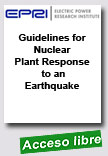 |
Guidelines for Nuclear Plant Response to an Earthquake
Electric Power Research Institute (EPRI), 15 October 2013, 100 p.
Guidelines for nuclear plant response to earthquakes enable utilities to evaluate in a timely manner the need for post-earthquake plant shutdown and to provide procedures for evaluation of earthquake effects on the plant, as well as criteria for plant restart. The procedures enable the responding team of operators and engineers to identify and assess any earthquake effects and, if shutdown is necessary, to return the |
plant to safe operation as rapidly as possible. The guidelines presented herein represent an update of guidance in EPRI report NP-6695, “Guidelines for Nuclear Plant Response to an Earthquake”, that was issued in December, 1989.
Experience from the response of nuclear power plants world-wide to strong earthquakes since issuance of EPRI report NP-6695 has shown that earthquakes may exceed the design Operating Basis Earthquake (OBE) and Safe Shutdown Earthquake (SSE) response spectra without causing damage to safety related structures, systems, and components (SSCs). EPRI report NP-5930 provides an analytical criterion for determining when an OBE is exceeded. EPRI report NP-6695 provides guidelines for a comprehensive plan for determining the need for plant shutdown (if not already shut down), assessing plant physical condition following an earthquake and the plant’s readiness for restart. This report updates EPRI NP-6695 to incorporate the experience gained and lessons learned from these more recent events.
Extraído de:
http://www.epri.com/abstracts/Pages/ProductAbstract.aspx?
ProductId=3002000720
|
 |
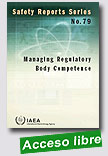 |
Managing Regulatory Body Competence
IAEA Safety Reports Series, 2014, 96 p.
The ability of a regulatory body to fulfil its responsibilities depends largely on the competence of its staff. Building employees’ skills and knowledge is an investment in each employee and in the future of the organization. This Safety Report publication provides generic guidance on managing the competence of regulatory bodies within their management system. It can be used as an example for Member States on how to meet the requirements of systematically assessing |
competence needs, in the near and long term, and delivering training and other elements of competence development, as well as continually improving this part of the management system.
Extraído de: http://www-pub.iaea.org/books/IAEABooks/10474/Managing-Regulatory-Body-Competence
|
 |
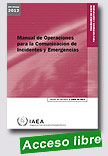 |
Manual de Operaciones para la Comunicación de Incidentes y Emergencias
OIEA, Diciembre de 2013, 88 p.
El objetivo que persigue el Manual de Operaciones para la comunicación de incidentes y emergencias (IEComm) es que su aplicación mejore el intercambio de información sobre incidentes y emergencias nucleares o radiológicos entre la Secretaría del OIEA, los Estados Miembros del Organismo, las Partes en las convenciones relativas a la pronta notificación y la asistencia, las organizaciones internacionales
|
correspondientes y otros Estados. El manual ofrece orientaciones a los Estados Miembros del OIEA, los Estados Parte y las organizaciones internacionales pertinentes para que elaboren disposiciones adecuadas que actúen recíprocamente como interfaz y con la Secretaría del OIEA. Además, IEComm ha sido concebido también de modo que contenga en un solo manual información práctica acerca de
cómo y cuándo recurrir a esas medidas.
Extraído de: http://www-pub.iaea.org/MTCD/Publications/PDF/EPR-IEComm2012_S_web.pdf |
 |
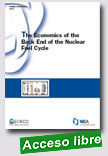 |
The feasibility and costs of spent nuclear fuel management and the consequent disposal of ultimate waste continue to be the subject of public debate in many countries, with particular concern often expressed over the lack of progress in implementing final disposal. Uncertainties about back-end costs and the financial risks associated with management of the back end have also been singled out as possible
|
deterrents to investment in new nuclear power plants.
This report offers an appraisal of economic issues and methodologies for the management of spent nuclear fuel and high-level waste from commercial power reactors. It includes a review of different back-end options and current policies and practices, with a focus on the cost estimates for these options and the funding mechanisms in place or under consideration in OECD/NEA countries. A generic economic assessment of high-level estimates of back-end cost impacts on fuel cycle costs is undertaken for selected idealised scenarios, by means of a simple static model. Sensitivity analyses are conducted for the evaluation of uncertainties in major components and the identification of cost drivers. Since factors other than economics are an important part of the decision-making process, an analysis of the influence of key qualitative parameters in the selection of back-end strategies is also presented in this report.
Français: Economie de l'aval du cycle du combustible nucléaire
Extraído de: http://www.oecdnea.org/tools/publication?query=&div=&lang=
&period=6m&sort=date&filter=1#p7061
|
 |
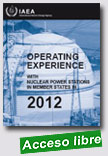 |
Operating Experience with Nuclear Power Stations in Member States in 2012 - 2013 Edition (CD-ROM)
IAEA, 2013, 3.528 p.
This CD-ROM contains the 44rd edition of the IAEA's series of annual reports on operating experience with nuclear power plants in Member States. It is a direct output from the IAEA's Power Reactor Information System (PRIS) and contains information on electricity production and overall performance of individual plants during 2012. In addition to annual information, the report contains a historical summary of performance
|
during the lifetime of individual plants and figures illustrating worldwide performance of the nuclear industry. The CD-ROM contains also an overview of design characteristics and dashboards (not included into the web version) of all operating nuclear power plants worldwide.
Extraído de:
http://www-pub.iaea.org/books/IAEABooks/10597/Operating-Experience-with-Nuclear-Power-Stations-in-Member-States-in-2012-2013-Edition-CD-RO
|
 |
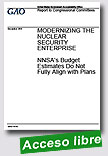 |
Modernizing the Nuclear Security Enterprise: National Nuclear Security Administration's Budget Estimates Do Not Fully Align with Plans
Government Accountability Office (GAO-US), December 10, 2013, 59 p.
The National Nuclear Security Administration's (NNSA) total budget estimates for modernizing the nuclear security enterprise for fiscal years 2014 through 2031 have increased by about $19 billion overall when compared with the estimates in the agency's fiscal year 2012 budget materials, with most of
|
the increase occurring in fiscal year 2019 and beyond. Factors such as sequestration, the achievability of planned cost savings, and pension liabilities could affect the accuracy of future budget estimates as presented.
Budget estimates for two of three areas discussed in NNSA's modernization plans may not represent total funding needed and therefore do not fully align with aspects of these plans. In the area of stockpile maintenance and refurbishment, budget estimates increased by $27 billion--accounting for more than the total increase of $19 billion to overall budget estimates for modernization--primarily due to changes in the way that NNSA calculated budget estimates for nuclear weapons refurbishment programs. However, NNSA's plans for two weapons refurbishment programs also indicate that additional funding may be needed before fiscal year 2019 to meet scheduled milestones. In the infrastructure and science, technology, and engineering capabilities areas, NNSA's budget estimates decreased slightly. However, in the infrastructure area, NNSA did not include in its budget estimates billions of dollars in planned major construction projects because officials said these infrastructure plans were too preliminary. Providing Congress with budget estimates that reflect long-term plans and the expected funding needed to execute these plans, even if preliminary, helps in prioritizing projects and funding and aids in congressional decision making.
Nuclear weapons have been and continue to be an essential part of the nation's defense strategy. The end of the cold war resulted in a shift from designing, testing, and producing new nuclear weapons to maintaining the existing stockpile indefinitely and extending the operational lives of these weapons through refurbishment, without nuclear testing. At the same time, the production infrastructure for nuclear weapons has become outdated.
The National Defense Authorization Act for Fiscal Year 2011 mandated GAO to report annually on whether NNSA's nuclear security budget materials provide for sufficient funding to modernize and refurbish the nuclear security enterprise. This report addresses (1) changes to NNSA's budget estimates for modernizing the nuclear security enterprise since fiscal year 2012 and (2) the extent to which these budget estimates align with NNSA's modernization plans.
To answer these objectives, GAO reviewed NNSA's fiscal year 2012 and 2014 nuclear security budget materials, which are composed of NNSA's budget request justification and its Stockpile Stewardship and Management Plan, which describes modernization plans and budget estimates for the next 20 years or longer. GAO also interviewed NNSA and DOD program officials.
GAO recommends that NNSA include a range of budget estimates for preliminary projects and programs in future modernization plans. NNSA generally concurred with the recommendation.
Highlights Page
Extraído de: http://www.gao.gov/products/GAO-14-45
|
 |
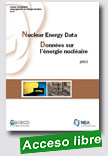
|
Nuclear Energy Data 2013
Nuclear Energy Agency (NEA), 2013, 95 p.
Nuclear Energy Data is the OECD Nuclear Energy Agency's annual compilation of statistics and country reports documenting the status of nuclear power in the OECD area. Information provided by member country governments includes statistics on installed generating capacity, total electricity produced by all sources and by nuclear power, nuclear energy policies and fuel cycle developments, as well as projected generating capacity and electricity production to
|
2035, where available. Total electricity generation at nuclear power plants and the share of electricity production from nuclear power plants declined in 2012 as a result of operational issues at some facilities and suspended operation at all but two reactors in Japan. Nuclear safety was further strengthened in 2012 following safety reviews prompted by the Fukushima Daiichi nuclear power plant accident. Governments committed to maintaining nuclear power in the energy mix pursued initiatives to increase nuclear generating capacity. In Turkey, plans were finalised for the construction of the first four reactors for commercial electricity production. Further details on these and other developments are provided in the publication's numerous tables, graphs and country reports.
This publication contains 'StatLinks'. For each StatLink, the reader will find a URL which leads to the corresponding spreadsheet. These links work in the same way as an Internet link.
Extraído de:
http://www.oecdnea.org/tools/publication?query=&div=
&lang=&period=6m&sort=date&filter=1#p7162
|
 |
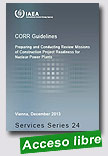 |
CORR Guidelines: Preparing and Conducting Review Missions of Construction Project Readiness for Nuclear Power Plants
IAEA Services Series, 2014, 106 p.
The construction readiness review (CORR) mission for nuclear power plant projects has been established with the aim of conducting peer reviews of construction projects related to nuclear power plants. Such a mission provides a detailed assessment of readiness for construction, construction progress, readiness for turnover, as well as recommendations for improvement. Organizations in Member States, such as
|
nuclear utilities, owners, regulators and technical support organizations, can benefit from such reviews.
A team of international experts with complementing specialities will conduct the
CORR mission. The review is based on appropriate IAEA publications, such as IAEA Safety Standards Series Guides and IAEA Nuclear Energy Series publications, as well as on internationally recognized project and construction management guides. Mission findings are summarized in a mission report, which includes a list of recommendations, suggestions and identified good practices.
The review is not intended to be a regulatory inspection or an audit against international codes and standards. Rather, it is a peer review aimed at improving implementation processes and procedures through an exchange of technical experiences and practices at the working level. The mission is applicable at any stage of a nuclear power plant construction project, although two specific phases are targeted: (1) start of construction mission (Phase 1 mission) and (2) an in-progress mission (Phase 2 mission). Missions are initiated when official requests are submitted by Member States through the appropriate IAEA channels.
Extraído de:
http://www-pub.iaea.org/MTCD/Publications/PDF/SVS-24_web.pdf
|
 |
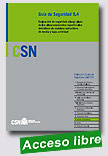 |
Evaluación de seguridad a largo plazo de los almacenamientos superficiales definitivos de residuos radiactivos de media y baja actividad
Consejo de Seguridad Nuclear, 2013, 18 p.
El propósito de esta guía es describir el contenido mínimo de la evaluación de seguridad a largo plazo de los almacenamientos definitivos superficiales de residuos radiactivos, que se debe elaborar por el titular de la instalación como parte del Estudio de Seguridad para la solicitud de las diversas autorizaciones de estas instalaciones (de construcción, de explotación, de modificación, de ejecución y
|
montaje de la modificación y de desmantelamiento). Independientemente del proceso de licenciamiento de la instalación, la seguridad a largo plazo podrá analizarse asimismo por el titular con anterioridad a la solicitud de las correspondientes autorizaciones, por ejemplo en la selección de emplazamiento, para el análisis previo del diseño y con anterioridad al cierre de la instalación de almacenamiento definitivo. El contenido mínimo de la evaluación de seguridad a largo plazo que desarrolla la guía es asimismo recomendado para estos procesos.
La guía se refiere a los almacenamientos definitivos superficiales de residuos radiactivos con contenido limitado de radionucleidos de largo periodo de semidesintegración. Estos residuos reúnen ciertas características físico-químicas y radiológicas, y pueden ser almacenados en instalaciones superficiales o cercanas a la superficie. En España se les denomina residuos radiactivos de baja y media actividad (incluyendo muy baja actividad) y son los que pueden ser almacenados en el centro de almacenamiento de El Cabril. La categorización de estos residuos, de acuerdo con la clasificación del OIEA (OIEA, 2009), corresponde a los residuos de baja actividad, incluyendo también los residuos de muy baja actividad.
Extraído de: https://www.csn.es/images/stories/publicaciones/unitarias/
guias_seguridad/GUIA_SEG_9_4_baja.pdf
|
 |
|
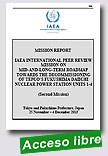
|
IAEA International Peer Review Mission on Mid-and-Long-Term Roadmap Towards Decommissioning of TEPCO's Fukushima Daiichi NPS Units 1-4 (Second Mission) (25 November-4 December 2013), Mission Report, 12 February 2014
IAEA, 12 February 2014, 72 p.
Following the accident at TEPCO’s Fukushima Daiichi Nuclear Power Station (NPS) on 11 March 2011, the “Mid-and-Long-Term Roadmap towards the Decommissioning of TEPCO’s Fukushima Daiichi Nuclear Power Station Units 1-4”
|
(hereinafter referred to the “Roadmap”) was adopted by the Government of Japan and the TEPCO Council on Mid-to-Long-Term Response for Decommissioning in December 2011. The Roadmap was revised in July 2012 and June 2013. The Roadmap includes a description of the main steps and activities to be implemented for decommissioning the Fukushima Daiichi NPS through the combined efforts of the Government of Japan and TEPCO.
Within the framework of the IAEA Action Plan on Nuclear Safety, the Government of Japan (Ministry of Economy, Trade and Industry – METI) invited the IAEA to conduct an independent peer review of the Roadmap with two main objectives: To improve the decommissioning planning and the implementation of pre-decommissioning activities at TEPCO’s Fukushima Daiichi NPS; and To share the good practices and lessons learned by the review with the international community.
Extraído de:
http://www.iaea.org/newscenter/focus/fukushima/final_report120214.pdf |
 |
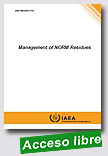 |
Management of NORM Residues
IAEA TECDOC, 2013, 53 p.
Naturally occurring radioactive material (NORM) may lead to exposures at some stage of its processing and in the use or reuse of products, residues or wastes. Several publications of the International Atomic Energy Agency have already addressed NORM issues with special focus on some of the more relevant industrial operations. This publication addresses the management aspects of NORM residues, including their disposal as waste, in a wide range of industrial activities involving minerals and raw materials. It also
|
addresses NORM residues at so-called legacy sites, that is, sites contaminated by past activities that were not regulated to present standards. The main intention of this publication is to provide guidance to Member States on good practice in the management of NORM residues, bearing in mind that there is no single approach that applies to all situations.
Extraído de:
http://www-pub.iaea.org/books/IAEABooks/10396/Management-of-NORM-Residues |
 |
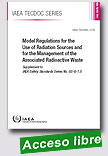 |
Model Regulations for the Use of Radiation Sources and for the Management of the Associated Radioactive Waste
IAEA TECDOC, 2014, 119 p.
This publication provides advice on an appropriate set of regulations covering all aspects of the use of radiation sources and the safe management of the associated radioactive waste. The publication provides the framework for the regulatory requirements and conditions to be incorporated into individual authorizations for the use of radiation sources in industry, medical facilities, research and education, and in agriculture. It |
|
| |
|
|
|
| |
|
|
|
| |
|
|
|
|
|
